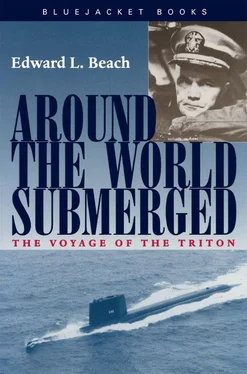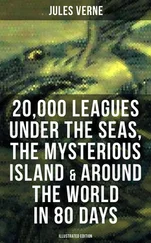I snatched the periscope when the report was given and made a long, searching inspection. There was no doubt about it. Lights were flashing red and green, and the bearings did not change. It must be an aircraft heading for us.
“Down scope,” I barked. “Secure ventilation. Take her deep.”
If it was indeed an aircraft coming right for us, possibly inspecting the surface of the water for want of anything more interesting to look at, we didn’t want to show the white froth of our propeller wake which would reveal the fact that something unusual had been there in the sea. I waited a perceptible time before giving the next order. “All ahead two-thirds.”
I could feel Triton angle downward gently and our speed begin to increase. Deliberately, I waited until the depth gauges showed there was a concealing cover of water over our screws before ordering, “All ahead full.”
Down we went into the friendly depths, on our way toward the Philippine Islands. I was somewhat disturbed that the aircraft had showed no signs of flying by, instead it had zeroed directly in on us.
From the Log:
Tuesday, 29 March 1943 Coming to periscope depth for routine night evolutions including ventilating and celestial observations.
1946 Aircraft contact bearing 070° true. Flashing red and green lights. Two nights in succession; maybe we have been detected. Who could be so persistent? Has he figured out our routine? Only a submariner could do that—maybe Admiral Benson, my ex-skipper and now ComSubPac, is playing games with us; or maybe the fliers in Guam have some extra gasoline to expend. Possibly they suspect a non-US submarine.
Two weeks before, we had received a message informing us that my old wartime skipper in USS Trigger, Commander (now Rear Admiral) Roy S. Benson, had taken over as ComSubPac. Our acquaintance had dated from my midshipman days, when he had been my instructor in seamanship and navigation, and well did I remember his propensity, as both instructor and skipper, for an occasional witticism at the expense of one of his less alert students or subordinates. There never was a sting to any of Admiral Benson’s humor, and usually there was a lesson to be learned. There was, for example, the day I navigated the old Trigger directly under the sun.
When the sun passes dead overhead, its altitude measures 90° no matter in what direction one looks, and a special type of observation known as a “high-altitude sight” must be worked out for a position. A running fire of semicaustic comment from Benson, to the effect that modern navigators didn’t know how to handle a high-altitude sight, that no Executive Officer of a submarine today, myself included, would know what to do about this situation, had impelled me to a rather searching investigation as to just how the situation was to be handled. When the calculated time came, I stood on the bridge and took shot after shot of the sun as we approached and passed through the subsolar point, finding later, to my astonishment, that I had been there for an hour and a half of continuous observation. Then, still fascinated with the unique navigational problem, I spent another couple of hours computing the results. When I was finished, I had produced a beautiful set of curves showing exactly where we had been during the entire period, all defined by a series of tiny intersecting arcs.
As nearly as I can now remember, Captain Benson’s comment, when I proudly showed him the results of my work, was something to the effect that any navigator worth a damn would have done the same. But the pleased look in his eyes gave my confidence a terrific boost.
In my own mind I knew that if Admiral Benson, ComSubPac, had learned that an unknown periscope had been detected off Guam, his aircraft would be sent out to find us. As officer in charge of all US submarines operating in the Pacific Fleet, he would have our basic itinerary and would know exactly where to send his planes. Their orders, couched in officialese though they might be, would be designed for the express purpose of “teaching that young fellow Beach how to run a submarine.”
Extreme caution with the periscope was thus in order. I recalled all my techniques of the war years, leaving the periscope up for short periods only, crouching as I used it so that only one or two inches of it were exposed. We had Triton making minimum speed, in order to create the smallest possible periscope feather in the dark waters. Under these conditions, even the best antisubmarine radar would have difficulty detecting the tip of our scope, while I looked carefully at the airplane in an effort to learn more about it. Once again, the bearing of the aircraft appeared to be nearly constant, and the thought flashed across my mind that it might be merely a regular commercial airliner flying between Guam and the Philippines. The alternately flashing red and green lights tended to bear out this theory. But after a few careful observations, spaced some time apart, it became apparent that the distance to the flashing lights did not seem to have changed perceptibly. Furthermore, there was something just a little strange about the alternations of the red and green lights….
Just as someone in the darkened conning tower, possibly Will Adams, commented that perhaps it would be a good idea to check the Nautical Almanac or the star charts, my brain which subconsciously had been trying to give me the right information all along, suddenly supplied the answer.
We had been fooled by a star millions of miles away! No wonder both the range and the bearing had seemed so nearly constant! I stood up from my half-crouching position and ran the periscope all the way up to the top.
In a few moments, the confirmation came from Chief Quartermaster Marshall, below in the chart room. Our visitor of two nights in a row was a navigator’s friend, the red star Arcturus, which, according to the Nautical Almanac, should have the altitude and bearing of our supposed aircraft at that very moment. The green light which had apparently alternated with the red was no doubt simply a refraction effect on the damp surface of our periscope lens.
My only comfort, as we laid aside our anxieties and went about the business of the night’s periscope depth routine, was that more than one submarine has dived for a rising star. During the war, three times in a row the ace submarine Tirante had dived when Venus came over the horizon—in one case, according to the excited lookout who saw it, accompanied by whirling propeller, machine-gun bullets, and the leering face of a Japanese pilot.
Thursday, 31 March, 1960, from the Log:
0545 As we cross the Philippine Trench, the bottom rises precipitously to the 100-fathom curve. Our echo-ranging sonar picks it out like a brick wall as we come up on it, and once again the gravity meter indicates a rapidly shoaling bottom.
A glance at any chart of the ocean depths will show that one of the deepest spots in the Pacific Ocean is the so-called Philippine Trench, lying on a north-and-south axis just to the east of the Philippine archipelago. As Triton approached the Trench, I remember looking with interest at the repeater scope of our search sonar. We were in a sea of nothingness. The limits of the huge trench were well beyond the range of sonar, the bottom so far away as to be like a void.
Our objective was Surigao Strait, and according to our chart the depth of water would reduce suddenly from thousands of fathoms to less than one hundred, if we were able to pick the spot accurately where the Strait entered the Philippine archipelago. If we missed the mark, the vertical wall of the Trench implacably stood in our path.
Silently and at reduced speed, our great ship glided toward the barrier, probing for the relatively small notch at the top which would be our entry point. Our navigation was accurate; that we knew. We had learned to have considerable faith in it over the weeks since we had left New London. But even so, there might be some unexpected current, some unexplained drift of the ocean waters which would sweep us a little bit one way or the other and cause us to miss the tiny V-shaped notch in the top of the wall toward which we were bound. Faced with the massiveness of nature, the hundreds and thousands of cubic miles of material deposited here, almost as though by design to bar our way, even the powerful and mighty Triton, the supreme effort thus far of man’s competition with his environment, suddenly appeared insignificant.
Читать дальше












